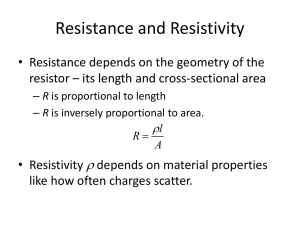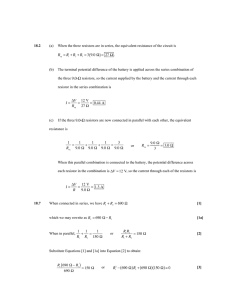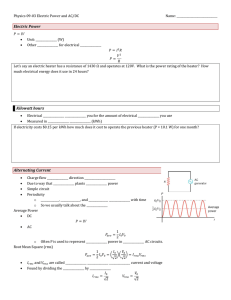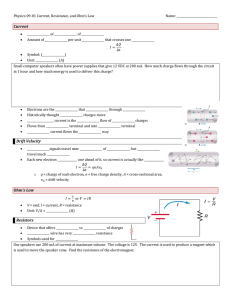Resistors in Series and Parallel Worksheet
advertisement
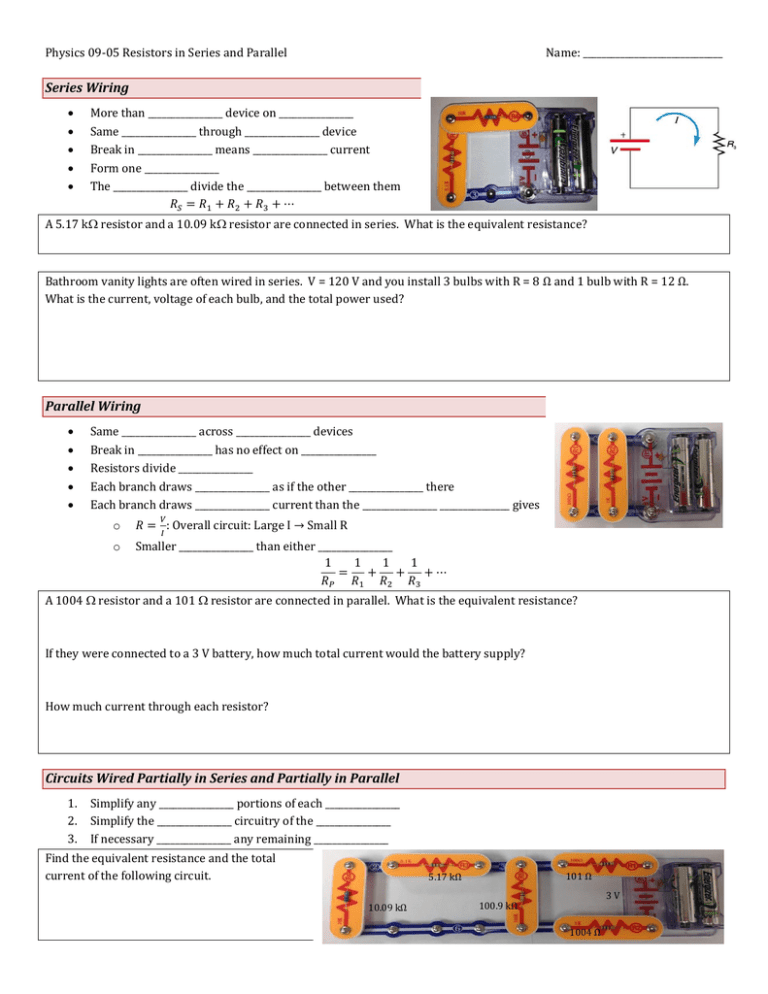
Physics 09-05 Resistors in Series and Parallel Name: ______________________________ Series Wiring More than ________________ device on ________________ Same ________________ through ________________ device Break in ________________ means ________________ current Form one ________________ The ________________ divide the ________________ between them 𝑅𝑆 = 𝑅1 + 𝑅2 + 𝑅3 + ⋯ A 5.17 k resistor and a 10.09 k resistor are connected in series. What is the equivalent resistance? Bathroom vanity lights are often wired in series. V = 120 V and you install 3 bulbs with R = 8 Ω and 1 bulb with R = 12 Ω. What is the current, voltage of each bulb, and the total power used? Parallel Wiring Same ________________ across ________________ devices Break in ________________ has no effect on ________________ Resistors divide ________________ Each branch draws ________________ as if the other ________________ there Each branch draws ________________ current than the ________________ _______________ gives 𝑉 o 𝑅 = : Overall circuit: Large I → Small R o Smaller ________________ than either ________________ 1 1 1 1 = + + +⋯ 𝑅𝑃 𝑅1 𝑅2 𝑅3 𝐼 A 1004 resistor and a 101 resistor are connected in parallel. What is the equivalent resistance? If they were connected to a 3 V battery, how much total current would the battery supply? How much current through each resistor? Circuits Wired Partially in Series and Partially in Parallel 1. 2. 3. Simplify any ________________ portions of each ________________ Simplify the ________________ circuitry of the ________________ If necessary ________________ any remaining ________________ Find the equivalent resistance and the total current of the following circuit. 101 Ω 5.17 kΩ 10.09 kΩ 3V 100.9 kΩ 1004 Ω Physics 09-05 Resistors in Series and Parallel Name: ______________________________ Find the equivalent resistance. 5.17 kΩ 10.09 kΩ 3V 100.9 kΩ 1004 Ω 101 Ω Homework 1. What is the voltage across the open switch Figure 1? 2. There is a voltage across an open switch, such as in Figure 1. Why, then, is the power dissipated by the open switch small? 3. Why is the power dissipated by a closed switch, such as in Figure 1, small? 4. A student in a physics lab mistakenly wired a light bulb, battery, and switch as shown in Figure 2. Explain why the bulb is on when the switch is open, and off when the switch is closed. (Do not try this—it is hard on the battery!) 5. Some strings of holiday lights are wired in series to save wiring costs. An old version utilized bulbs that break the electrical connection, like an open switch, when they burn out. If one such bulb Figure 2 burns out, what happens to the others? If such a string operates on 120 V and has 40 identical bulbs, what is the normal operating voltage of each? Newer versions use bulbs that short circuit, like a closed switch, when they burn out. If one such bulb burns out, what happens to the others? If such a string operates on 120 V and has 39 remaining identical bulbs, what is then the operating voltage of each? 6. Suppose you are doing a physics lab that asks you to put a resistor into a circuit, but all the resistors supplied have a larger resistance than the requested value. How would you connect the available resistances to attempt to get the smaller value asked for? 7. (a) What is the resistance of ten 275-Ω resistors connected in series? (b) In parallel? (OpenStax 21.1) 2.75 kΩ, 27.5 Ω 8. (a) What is the resistance of a 1.00 × 102 -Ω , a 2.50-kΩ, and a 4.00-k Ω resistor connected in series? (b) In parallel? (OpenStax 21.2) 6.60 kΩ, 93.9 Ω 9. What are the largest and smallest resistances you can obtain by connecting a 36.0-Ω, a 50.0-Ω, and a 700-Ω resistor together? (OpenStax 21.3) 786 Ω, 20.3 Ω Figure 1 10. An 1800-W toaster, a 1400-W electric frying pan, and a 75-W lamp are plugged into the same outlet in a 15-A, 120-V circuit. (The three devices are in parallel when plugged into the same socket.). (a) What current is drawn by each device? (b) Will this combination blow the 15-A fuse? (OpenStax 21.4) 15 A, 11.7 A, 0.63 A, yes 11. (a) Given a 48.0-V battery and 24.0-Ω and 96.0-Ω resistors, find the current and power for each when connected in series. (b) Repeat when the resistances are in parallel. (OpenStax 21.6) 0.400 A, 3.84 W, 15.4 W; 2.5 A 12. A 240-kV power transmission line carrying 5.00 × 102 A is hung from grounded metal towers by ceramic insulators, each having a 1.00 × 109 -Ω resistance. (a) What is the resistance to ground of 100 of these insulators? (b) Calculate the power dissipated by 100 of them. (c) What fraction of the power carried by the line is this? (OpenStax 21.10) 𝟏. 𝟎𝟎 × 𝟏𝟎𝟕 𝛀, 𝟓. 𝟕𝟔 × 𝟏𝟎𝟑 W, 𝟒. 𝟖𝟎𝟏 × 𝟏𝟎−𝟓 13. Two resistors, one having a resistance of 145 Ω, are connected in parallel to produce a total resistance of 150 Ω. (a) What is the value of the second resistance? (b) What is unreasonable about this result? (c) Which assumptions are unreasonable or inconsistent? (OpenStax 21.12) −4350 Ω 14. Two resistors, one having a resistance of 900 kΩ, are connected in series to produce a total resistance of 0.500 MΩ. (a) What is the value of the second resistance? (b) What is unreasonable about this result? (c) Which assumptions are unreasonable or inconsistent? (OpenStax 21.13) −400 kΩ
